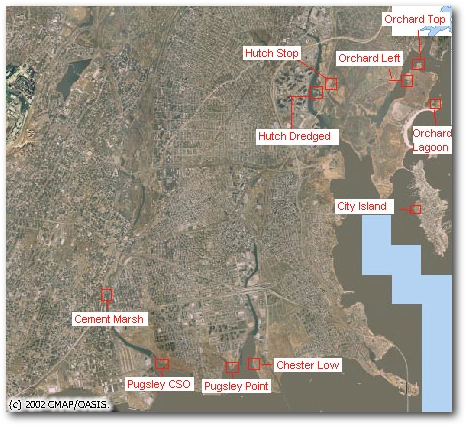
Salt Marsh Keystone Species Study
During the field seasons of 2003 and 2004, the Gaia Institute carried out an extensive salt marsh monitoring program within the salt marsh habitats in the Southern and Eastern Bronx. The purpose of this research was to document the growth and development of Spartina alterniflora from the lowest portion of low marsh edge to the high marsh or high tide mark above which cordgrass no longer grew. The results of this work will be used to evaluate the interaction of ecology and hydrology for the purposes of enhancing restoration efforts in the region.
Several forms of Spartina growth are typically characteristic within a salt marsh. Prior research (by Mark Bertness) has shown that taller cordgrass grows along the marsh edge and extends into the marsh flat, and a short-form occurs at higher elevations. This work has shown that cord grass growth is stunted by substrate texture, nutrient availability, and the overall energy supply to these plants. Higher growth is seen in portions of the marsh inhabited by ribbed mussels and fiddler crabs. Our research aims to discern if the systems in the Eastern Bronx depend on similar ecological controls, and how this may be impacted by combined sewers, the age of the marsh, and it’s elevation.
Because it has already been shown that that fiddler crab and ribbed mussel densities greatly and positively contribute to the overall energy supply of salt marsh system, our aim was to see if these symbionts had similar effects in urban marshes. Preliminary results of our study indicate that Spartina growth is roughly correlated with fiddler crab and mussel density. In general, high densities of fiddler crabs and mussels were correlated with greater cord grass biomass. This data, along with the previous work of Bertness, supports the hypothesis that Spartina growth is enhanced by these keystone biological components, even in zones of expected high nutrients around combined sewer outfalls.
This work suggests that salt marsh restoration in and around the Bronx River and the City should couple planting stands cordgrass with colonization by fiddler crabs and ribbed mussels. This approach would better ensure that such marshes would function better in terms of ecological productivity, and most probably also as active filters of local waters and support systems for biological diversity. By ensuring that restored marshes are populated with mussels and fiddler crabs, the crab burrows will increase oxygen which is carried into the sediments, increasing the marshes' ability to breakdown pollutants and remove excess nutrients. Ribbed mussels greatly increase the quantity of water that moves through the marsh, removing plankton and bacteria, and making nitrogen-rich deposits available to sustain plant growth.
At present, the Gaia Institute is working with the NYC Department of Environmental Protection and the NYC Department of Parks and Recreation to explore the effects of the establishment of this biologically diverse assemblages of marshes and oyster reefs in terms of potential impacts on water quality and biodiversity at the mouth of the Bronx River and near the outlet of the Hunts Point Wastewater Treatment Plant.
Salt Marsh Keystone Species Study
(Photo: Aerial view of Bronx River Watershed restoration activity location)

(Image: Aerial photo of sampling locations)
The Gaia Institute - 440 City Island Avenue - Bronx, NY 10464
